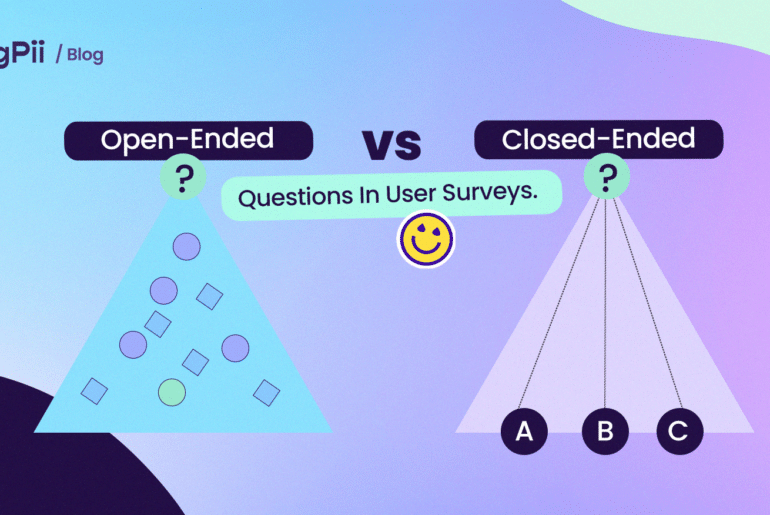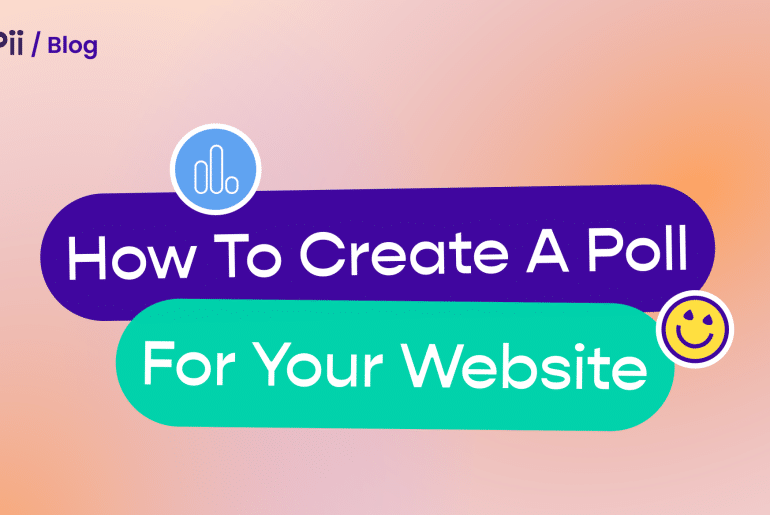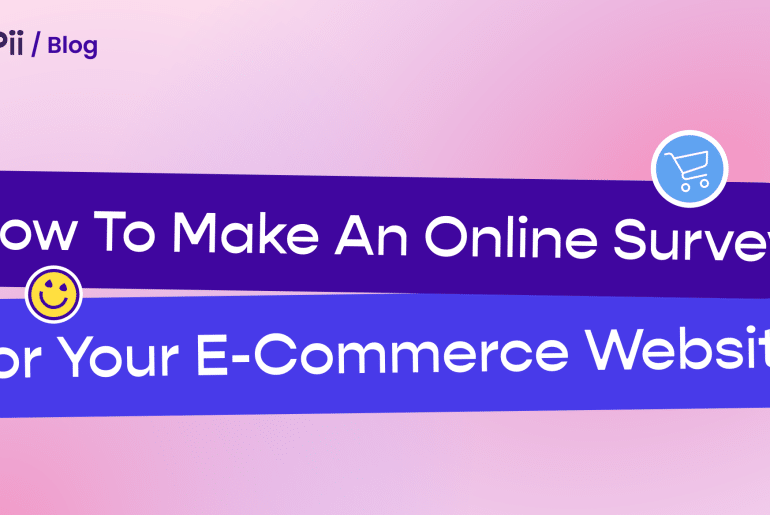According to Qualaroo, 53% of customers feel that brands fail to meet their standards.
The reason?
There is a gap between customer expectations and reality. So, who’s to blame?
Companies, obviously!
Most companies still don’t put in the effort to reach out to their targeted customers and talk to them about what they expect. Reaching out to customers is not as difficult as it used to be before the internet days.
You can now use many tools to get different kinds of customer feedback. One of those tools is customer surveys.
Here at FigPii, we’ve mad love for surveys, and they are part of the tools we offer in our suite of user behavior analytics tools.
Anyways, enough about the FigPii tools. In this article, we will talk about how to collect customer feedback using surveys, and we will show you the different types of customer surveys.
We know that plenty of blogs, webinars, and podcasts talk about customer surveys. What makes this blog different is that we get into the nitty-gritty, show you exactly how to do it, and walk away with a list of survey questions that you can use right away.
Now, before you start running a survey, you should approach it with a clear understanding of what you need from it?
- Are you running it to understand your end-users?
- Inform the direction of a design?
- Or assess a live website?
When you have your answers, you will easily decide upon a type of survey and the collection method you should use.
Types of User Surveys With Examples
1- Motivators’ User Survey
Motivators’ User Survey is used to help you understand what motivates customers to move from awareness to making a purchase.
It consists of 20 – 25 questions that take 5 to 6 minutes to complete.
Through Motivators’ User Survey, you can know more about your service or product’s real and perceived value.
The best place for this type of survey is your landing pages.
This type of survey can help you know:
Why do customers visit your website?
What do customers value the most?
Where did your visitors hear about you?
Here are a few examples of questions you can include in your motivator user survey:
- What brings you to our website?
- What are you looking to do on our website?
- How did you hear about us?
- Why did you come to this site today?
- What were you hoping to find on this page?
2- Barriers’ User Survey (Fears, Uncertainties, and Doubts)
Of course, some of your visitors will have barriers or FUDs (Fears, Uncertainties, and Doubts), which can be why they don’t convert.
How to fix this issue?
Barriers’ User Survey is one way to fix this problem, especially when they are launched on cart or checkout pages.
It can help you discover the barriers preventing your website visitors from conversion and avoid them.
Here are a few examples of questions you can include in your Barriers’ survey:
- Is there anything preventing you from completing your purchase?
- What’s the one thing that nearly stopped you from placing your order?
- Was there anything about this checkout process that we should improve?
- What prevented you from doing what you came to the site to do?
- What was your biggest fear or concern about using us?
- What was your biggest fear or concern about purchasing from us?
- If you did not make a purchase today, can you tell us why not?
- What would’ve convinced you to complete the purchase of the item(s) in your cart?
- Do you have any questions before you complete your purchase?
- What could we do to make our website more useful?
- Is there anything on this site that doesn’t work the way you expected it to?
3- Hooks’ User Survey
Hooks’ User Surveys discover what gets your visitors “hooked.” They help you understand what made them convert.
You can set this type of survey on the most popular pages of your website. Also, send them to your recent customers because they are loyal to your products and will be willing to answer questions.
Here are a few examples of questions you can use in a hooks’ user survey:
- What is the thing you liked the most about our website?
- What’s one feature we can add to make our product indispensable for you?
4- Customer Satisfaction User Survey
This type of survey can help you understand what customers think of your website.
One of the most prominent surveys of this type is the net promoter score.
It measures the customer’s willingness to recommend your brand to their family and friends.
Here are a few examples of questions to use in this type of survey:
- How likely would you recommend our product/service to your friends?
- Could you please rate your website experience today from 1 (poor) to 5 (very good)?
- How did you enjoy your website experience today?
- Did our website meet your expectations?
- Is there anything on this site that doesn’t work the way you expected it to?
How to Create Effective User Surveys?
Well, if I were in your place and just read about the types of surveys and I now know which type I am focusing on, my following questions would be:
How should I create one?
What to focus on while creating one?
Well, according to Khalid, FigPii CEO, the first thing you need to do is to understand what is the goal you want to achieve from this survey:
“Start with a clear goal. The smaller and more defined the goal is, the better the survey will be.
Instead, I would do 5 surveys focusing on different areas about my customers instead of a single survey asking 5 different questions.“
He also adds that another important thing to focus on while creating a survey is user segmentation:
“You should decide which user segment is best suited to answer your questions.
For example, if you ask about users’ experience using a certain product, then people who already bought from you are the best segment for your survey.“
As for the type of questions you should ask, some might think that not having too many open-ended questions is the safest option to conduct a survey.
However, according to Khalid, this can be good and dangerous at the same time:
It is good because it allows you to narrow down the answers. However, also bad because if you aren’t careful, you might drive people towards a preconceived notion that you might have. So, you are using data to prove a point.
That’s why there is another question you need to think about: for all these questions, what are the sources?
A good practice process would be to add another option and validate that the answers people provided make sense and match your preconceived notions.
The last thing you need to do is figure out the time to trigger the survey. Ensure that the targeting and triggering make sense to the type of survey you want to launch.
What to Avoid While Running User Surveys?
Here are the top mistakes that people make while conducting surveys that you should avoid, as per Khalid:
1- Sometimes people forget that surveys give you very few data points from many people.
That means that surveys miss the context; they don’t present the full image. Even though they are important, you can make the wrong decisions without having the real context.
2- Some people rely on surveys as the single tool for user research, which is a huge mistake.
Yes, they are good in specific circumstances, but they will never substitute for one-on-one customer interviews.
Instead, you can use surveys as a way to validate insights you get from interviews.
3- Another mistake is when people have a predefined notion for what people might answer.
For example, when you ask the visitor, “why you didn’t buy from us?” and list answers like “the price selection” or “I am not ready to buy.”
Why don’t you list other options? Why do you assume that these are the only reasons?
Limiting the options can hinder the value of your survey.
Now, after learning a bit about user surveys and what to avoid, here are some of the well-known user survey tools out there that can help you:
Top User Survey Tools
You need to select a tool that meets your needs.
Here are the most popular User Survey tools:
FigPii

FigPii Pros
- FigPii shows you your users’ individual responses and data on graphs.
- FigPii allows you advanced targeting for your polls so that you can have custom triggers. Advanced targeting options can be campaign targeting (Ex: targeting users coming from a specific ad campaign), visitors targeting, and source targeting (Ex: targeting users coming from LinkedIn).
- Moreover, FigPii doesn’t charge you for these options.
- It also allows you JavaScript targeting to launch your poll based on a specific cookie value.
- Polls tool is included in all FigPii packages from the smallest to the biggest.
- You can customize how the poll looks. You can custom design using JavaScript or CSS.
- FigPii allows you to change the language of the poll. It supports a right-to-left setup and vice versa.
- It also has advanced logic, which means you can change the flow of the questions. For example, if your user answers a Yes or No question, you can ask them follow-up questions regarding why they have responded with a no.
FigPii Pricing
Lucky Orange

Lucky Orange Pros & Cons
Lucky Orange has many pros and cons like:
As for the pros:
- Lucky Orange provides real-time polling.
- Lucky Orange enables you to send questions directly to customers and quickly get answers to questions you are interested in.
And the cons:
- You can only do up to 4 answers and only radial style, no dropdowns.
- You can’t exclude surveys on specific pages; you can just add certain pages.
Lucky Orange Pricing
Starter: $10 per month
Small business: $20 per month
Medium business: $50 per month
Large business: $100 per month
Hotjar

Hotjar Pros & Cons
As for the pros:
- You can collect feedback from users while running surveys.
- The polling element is beneficial for sites with lower quantities of site visitors.
- You can take surveys from users on any specified page on the website. You can put them on individual pages that need improvement to gain insights.
- Surveys on Hotjar are easy to intercept; Easy to create, target, and analyze whether you want to recruit 5 people to interview or survey 10,000 people to generate segmentation data.
As for the cons:
- You can’t segment who you provide your surveys to.
- You don’t have access to more options in regular surveys, such as the ability to rate options from 1 to 5 in a table with multiple columns and lines.
Hotjar Pricing
Basic: Free.
- Up to 35 daily sessions
- Automatic data capture
- Unlimited heat maps
- Up to 1,050 recordings/month
- Create and store 3 surveys & incoming feedback widgets
Plus: $39/month.
For small teams
Everything included in Basic, and:
- Up to 100 daily sessions
- Powerful filters for recordings
- Trigger recordings by page or event
- Up to 3,000 recordings/month
- Unlimited surveys & incoming feedback widgets
Business: From $99/month.
For growing companies & websites
Everything in Plus, and:
- Up to 500 daily sessions
- Seven custom-built integrations
- Analyze key user cohorts
- Rage clicks and u-turns
- Removal of Hotjar branding
Scale: From $389/month
For large companies & websites
Everything in Business, and:
- Up to 4,000 daily sessions
- Dedicated customer success manager
- SAML single sign-on (SSO)
- Enough data for the largest sites
- Full access to every feature
PollDaddy

Poll Daddy Pros & Cons:
The pros are:
- CrowdSignal Polls are easy to use and set up, giving you quick and responsive polls which you can integrate with your website.
- You can add a variety of questions.
- Poll Daddy is optimized for mobile devices.
- It has the option in settings to only allow one response per device.
As for the cons:
- Poll Daddy polls don’t have many options. For example, you can’t monitor IP addresses to prevent multiple votes by a single user. Or, you can’t optimize the uploaded images within the tool itself.
- The option that can allow you to choose only one response per device only works on computers, not mobile devices.
Poll Everywhere

Poll Everywhere Pros & Cons:
The pros are:
- The system is very interactive and comes up with a very easy UI to integrate questions you want.
- Poll Everywhere works with any device.
- The polls are URL-based, which allows you to engage with both an in-person and remote audience simultaneously.
- PPT Integration is very easy, even for novice technical users.
- There are some limitations on how many users can answer poll questions (depending on the package/level you choose).
As for the cons:
- There is no rating on a sliding scale feature. Instead, you have to create 5 different answers of 1-5 as multiple-choice, which skews the analytics.
- Many of the best features are based in the upper tiers of the pricing features.
- For anyone still unfamiliar with the tool, it can be a bit confusing to use the system via mobile at first.
Several numbers/codes need to be submitted to ensure your responses go to the right place and are included in the group discussion/responses.
Question Pro

Question Pro Pros & Cons:
The pros are:
- Question Pro has a tracking feature that lets you see how many are opening, starting, and especially completing your survey.
- It is easy to use on the participant’s side, even for people who may not be especially tech-savvy.
- QuestionPro provides a wide variety of capture types, including the ability for respondents to use their fingers to provide digital signing.
- It offers comprehensive analytics features. Responses are easily transmitted into graphs and easy-to-digest reports.
- It permits multiple users to access data while the survey is active and simultaneously with one another.
- It offers a wide range of question types and sophisticated options such as randomizing responses and logic trees.
As for the cons:
- If you create a multiple-choice question and want the participant to receive different feedback depending on what answer(s) they select, that can take a while.
- It creates effective data graphs and charts but lacks presentation capabilities that could benefit smaller organizations without presentation templates.
- Some of the advanced report options are only available online.
- Although the pricing is reasonable, you need to pay for the more advanced features.
Wrapping Things Up
Now, you have everything you need to know about user survey tools: types of surveys, what to consider while creating them, which things to avoid, and some of the best tools available.
However, important reminder, as I have mentioned above:
Yes, user surveys are a vital user research tool. However, it needs to go hand in hand with user interviews.




